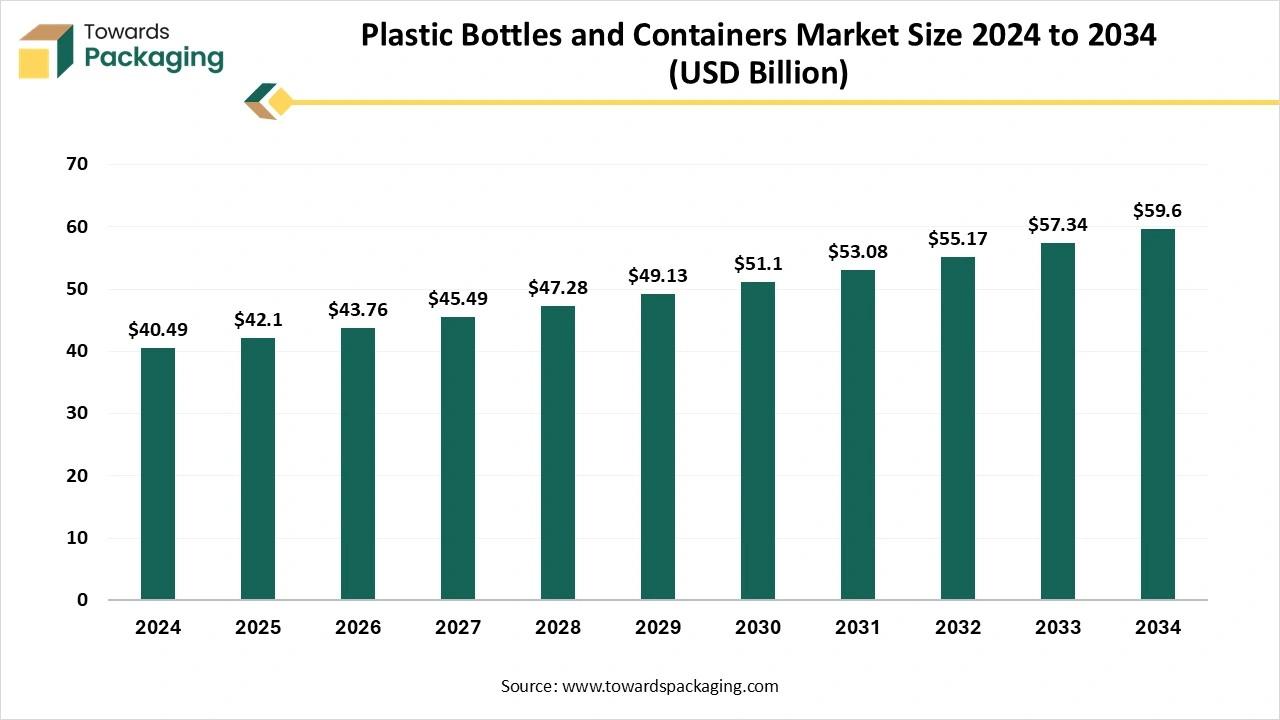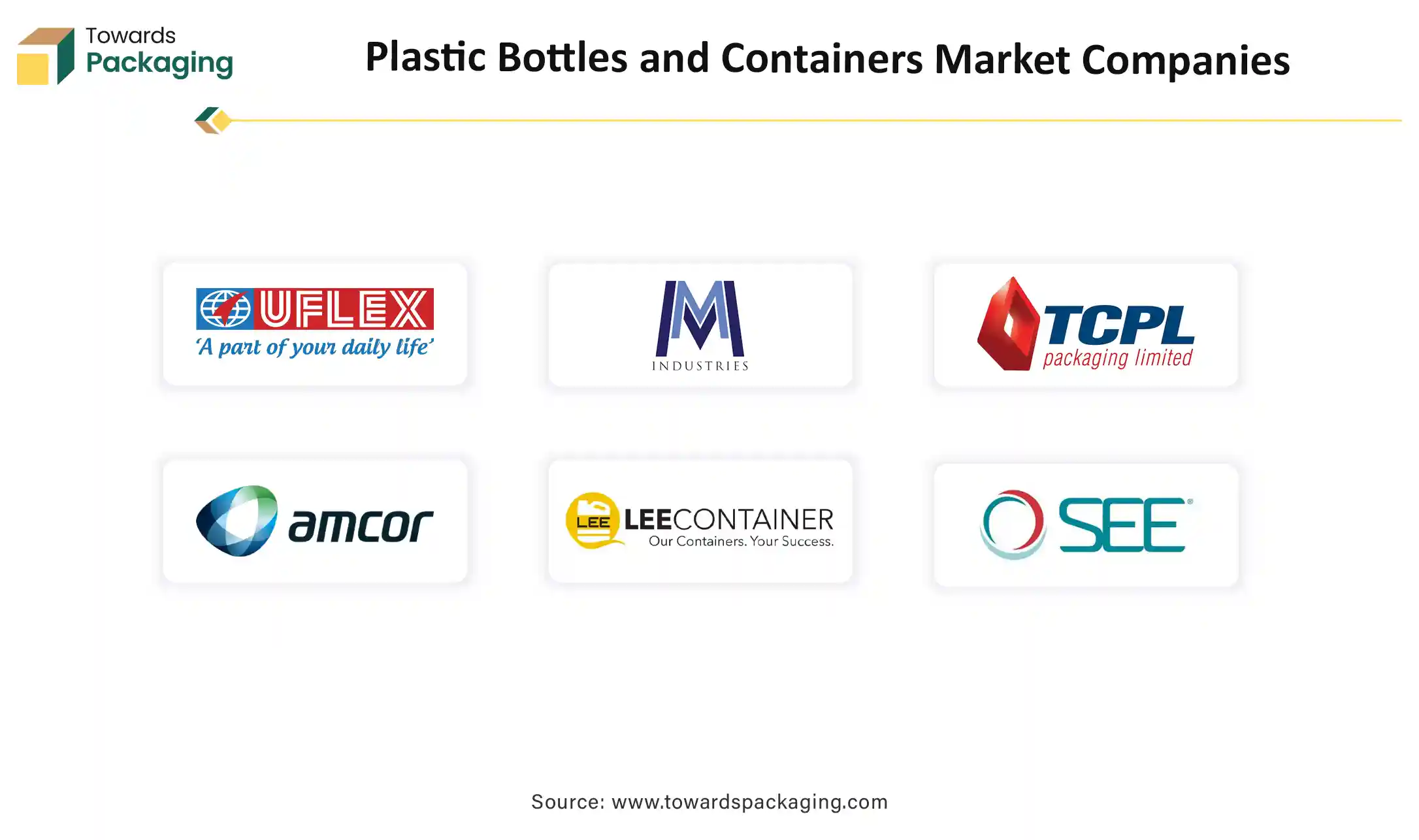November 2025
The plastic bottles and containers market is projected to grow from USD 42.1 billion in 2025 to USD 59.6 billion by 2034, registering a CAGR of 3.94%. This report covers full market dynamics, key trends, and segmentation by material (PET, HDPE, PP, LDPE) and end-use industries (beverages, food, cosmetics, pharmaceuticals, household care). It also provides detailed regional insights across North America, Europe, Asia-Pacific, Latin America, and MEA, highlighting North America’s dominance in 2024 and APAC’s fast growth. The study further analyzes leading companies such as Amcor, Berry Global, Uflex, Sonoco, CKS Packaging, alongside value chain mapping, trade data, global production clusters, and profiles of major manufacturers and suppliers.

Plastic bottles and containers are made up of various types of plastics such as polyvinyl chloride (PVC), polyethylene terephthalate (PET), polycarbonate (PC), polyethylene (PE), and polypropylene (PP). These are extensively utilized to maintain the quality of the packaged products for a long time. These plastic bottles and containers have a low risk of breakage, unlike glass containers and bottles, which attract a huge number of customers towards this market. This is considered to be suitable for the storage of food products, mainly for people travelling. These containers are widely used by restaurants for delivering food products without damaging the quality. There are several market players, such as AG POLY PACKS PRIVATE LIMITED, Anirudh Plastic Pvt Ltd, JSK PLASTIC INDUSTRIES, Altium Packaging LLC, Berry Global, U.S. Plastic Corporation, and several others are continuously working towards introducing bio-based resources for manufacturing such containers as an eco-friendly solution for the storage of products.
| Metric | Details |
| Market Size in 2024 | USD 40.49 Billion |
| Projected Market Size in 2034 | USD 59.6 Billion |
| CAGR (2025 - 2034) | 3.94% |
| Leading Region | North America |
| Market Segmentation | By Material, By End-user and By Region Coveredy |
| Top Key Players | Uflex, M & M Industries Inc, TCPL Packaging, Amcor plc, Lee Container Corporation, Sealed Air, Sonoco, CKS Packaging. |
Growing Demand for High-Durable Packaging
The growing demand for high durable containers and bottles that can be used several times has influenced the demand for this market. The long-lasting nature and low breaking risk have attracted a huge number of brands to this market. These are widely used for the storage of clothes, which makes durability quality essential for containers
Cost Effectiveness of Plastic Materials
The cost-effective solution for packaging is the major reason behind the growth of the demand for plastic bottles and containers. Plastic is cheaper than wood, glass, or any other material, which makes it an ideal choice for brands to use plastic containers in various sectors such as pharmacy, clothing, food and beverages, and many others.
Easy to Store and Transport
Plastic bottles and containers take up less space and require low maintenance for storage purposes. These are lighter, which makes them convenient to carry products while travelling.
Easy Customization Options
The rising customization demand in several industries has raised the usage of plastic containers and bottles, as these can be easily customized in several shapes and sizes, which raises the convenience to the customers and helps brands to promote their products.
AI plays a crucial role in the modification of the plastic bottles and containers market as it allows brands to understand the demand for packaging, which avoids surplus production of bottles and containers. AI-driven AMP Robotics is widely used for checking material quality that can be easily recycled and reducing the contamination risk. It optimizes the supply chain distribution by analysing the transportation routes. With the incorporation of AI, there is a huge innovation in sustainable designs being introduced in the plastic bottles and containers market. Brands use artificial intelligence to recycle plastic containers and bottles effectively. It is extensively used for manufacturing bio-based plastic containers and bottles that can be decomposed and help brands to promote eco-friendly packaging.
Rising Demand for Packaged Food and Beverages
The rising demand for packaged food and beverages has influenced the demand for the plastic bottles and containers market. There is a huge growth in urbanization, which has changed the lifestyle of individuals, as well as an increasing number of working individuals has enhanced the demand for packaged food products. The growing restaurant business has a huge impact on the packaging of food and beverages, and finding innovative ways to address it. The growing facilities of ready-to-eat meal services, snacks, dairy items, sauces, and the presence of a wide variety of beverages have influenced the plastic packaging industry profoundly. This type of packaging is mostly used by the food and beverage industry as it is lightweight and easily customization, facility has facilitated the development of the industry.
Moreover, plastic materials such as PET and HDPE work as excellent barriers and extend the shelf life of the packaged products. For instance, West Bengal has seen a consumption expenditure growth of 151%, while during the same period, Tamil Nadu witnessed a growth of approximately 214%. The small state of Sikkim saw consumption expenditure growth of a massive 394%. Overall, we find that growth for rural households was higher than for urban households, 164% for rural households versus 146% for urban households. The rise in food delivery and the e-commerce industry has fuelled the necessity for secure, tamper-proof, and reliable packaging.(Source: Nomura)

Growing Ecological concern Among People Limited the Development
The continuous growth towards rising ecological issues has hindered the development of the plastic bottles and containers market. There are abundant calls to decrease plastic practice as a consequence of rising concerns about pollution due to plastic and its damaging effects on human health, ecosystems, and marine life. Governments across the world are implementing guidelines to limit plastic waste, including bans on one-time usage of plastics and commands for biodegradable or recyclable packaging.
Growing Initiatives for Research Work
The continuous investment of the major market players in various sectors has influenced the development of the research work in the plastic bottles and containers market. Several market players are collaborating for the development of an advanced form of bio-based plastic bottles and containers that have less harmful effects on the environment. For instance, in March 2024, NAPCOR collaborated with Franklin Associates to discover the ecological influences of beverage bottles and cans in the U.S. The result is a Life Cycle Assessment report that provides fact-based, science-driven evidence that concludes, when compared to glass and aluminum, PET plastic delivers significant environmental savings across several key environmental categories.
Approximately 70% of beverage bottles and containers utilize plastic packaging, which is extracted from polyethylene terephthalate (PET) because of its lightweight quality, transparent nature, and complete recyclability. Polyethylene terephthalate plastic bottles and containers generate less solid waste, require less water during the production process, and release fewer pollutants that lead to smog and acid rain than aluminum and glass beverage containers. As ecological awareness grows, the higher sustainability profile of polyethylene terephthalate plastic containers and bottles assists as a major driver for their acceptance. This generates opportunities for the development of the worldwide market.
The polyethylene terephthalate (PET) segment held a dominant presence in the plastic bottles and containers market in 2024. It dominates this market due to its lightweight nature, excellent barrier quality, and durability, making it highly suitable for packaging. In industries such as pharmaceuticals and food and beverages, these are widely used due to their transparency, which makes the quality of the packaged products visible.
The high-density polyethylene (HDPE) segment is expected to grow at the fastest rate in the market during the forecast period of 2024 to 2034. It has excellent chemical-resistant properties, which influence this market to grow rapidly with the growth of the healthcare and research industry.
The beverages segment accounted for a considerable share of the plastic bottles and containers market in 2024. It is due to the rising trend for soft drinks and bottled water among people. The growing demand for enhancing the shelf life of food products has raised the utilization of these packaging bottles and containers, which can be used several times.
The food segment is anticipated to grow with the highest CAGR in the market during the studied years. It is due to a huge demand for a variety of shapes and sizes of packaging bottles and containers. The cosmetic company also has a huge demand for such plastic bottles and containers for the safe packaging and transportation of the products.
North America region held the largest share of the plastic bottles and containers market in 2024, due to the high capacity of manufacturing packaging in countries such as the U.S and Canada. The market is significantly shifting towards sustainable choices for the packaging of products, which promotes innovation in this market. The major focus is to develop packaging that can be recycled easily, which can be considered an eco-friendly option. PET plastic containers and bottles emit fewer greenhouse gases, which boosts the development of this market rapidly.
California leads with the most comprehensive plastic reduction policies, including the recent passage of laws requiring all plastic packaging to be recyclable or compostable by 2032. And Canada aims to achieve zero plastic waste by 2030. (Source: Ukhi India Pvt. Ltd.)
The Asia Pacific region is anticipated to grow at the fastest rate in the plastic bottles and containers market during the forecast period. It is due to a rapid shift towards urban areas, rising consumer demand, and industrialization that has influenced the demand for this market to grow significantly. In countries such as Japan, India, and South Korea, the growing disposable income is also a major reason behind the growth of the market.

By Material
By End-user
By Region Covered
November 2025
November 2025
November 2025
November 2025